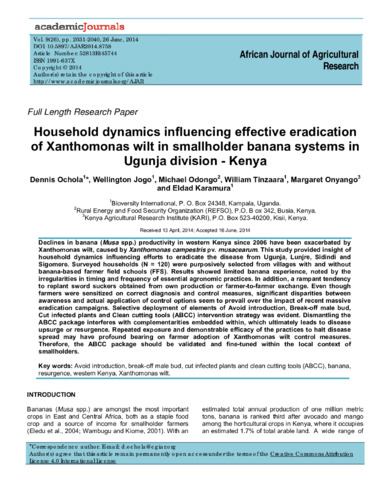Household dynamics influencing effective eradication of Xanthomonas wilt in smallholder banana systems in Ugunja division-Kenya
Declines in banana (Musa spp.) productivity in western Kenya since 2006 have been exacerbated by Xanthomonas wilt, caused by Xanthomonas campestris pv. musacearum.This study provided insight of household dynamics influencing efforts to eradicate the disease from Ugunja, Lunjre, Sidindi and Sigomere. Surveyed households (N = 120) were purposively selected from villages with and without banana-based farmer field schools (FFS). Results showed limited banana experience, noted by the irregularities in timing and frequency of essential agronomic practices. In addition, a rampant tendency to replant sword suckers obtained from own production or farmer-to-farmer exchange. Even though farmers were sensitized on correct diagnosis and control measures, significant disparities between awareness and actual application of control options seem to prevail over the impact of recent massive eradication campaigns. Selective deployment of elements of Avoid introduction, Break-off male bud, Cut infected plants and Clean cutting tools (ABCC) intervention strategy was evident. Dismantling the ABCC package interferes with complementarities embedded within, which ultimately leads to disease upsurge or resurgence. Repeated exposure and demonstrable efficacy of the practices to halt disease spread may have profound bearing on farmer adoption of Xanthomonas wilt control measures. Therefore, the ABCC package should be validated and fine-tuned within the local context of smallholders

